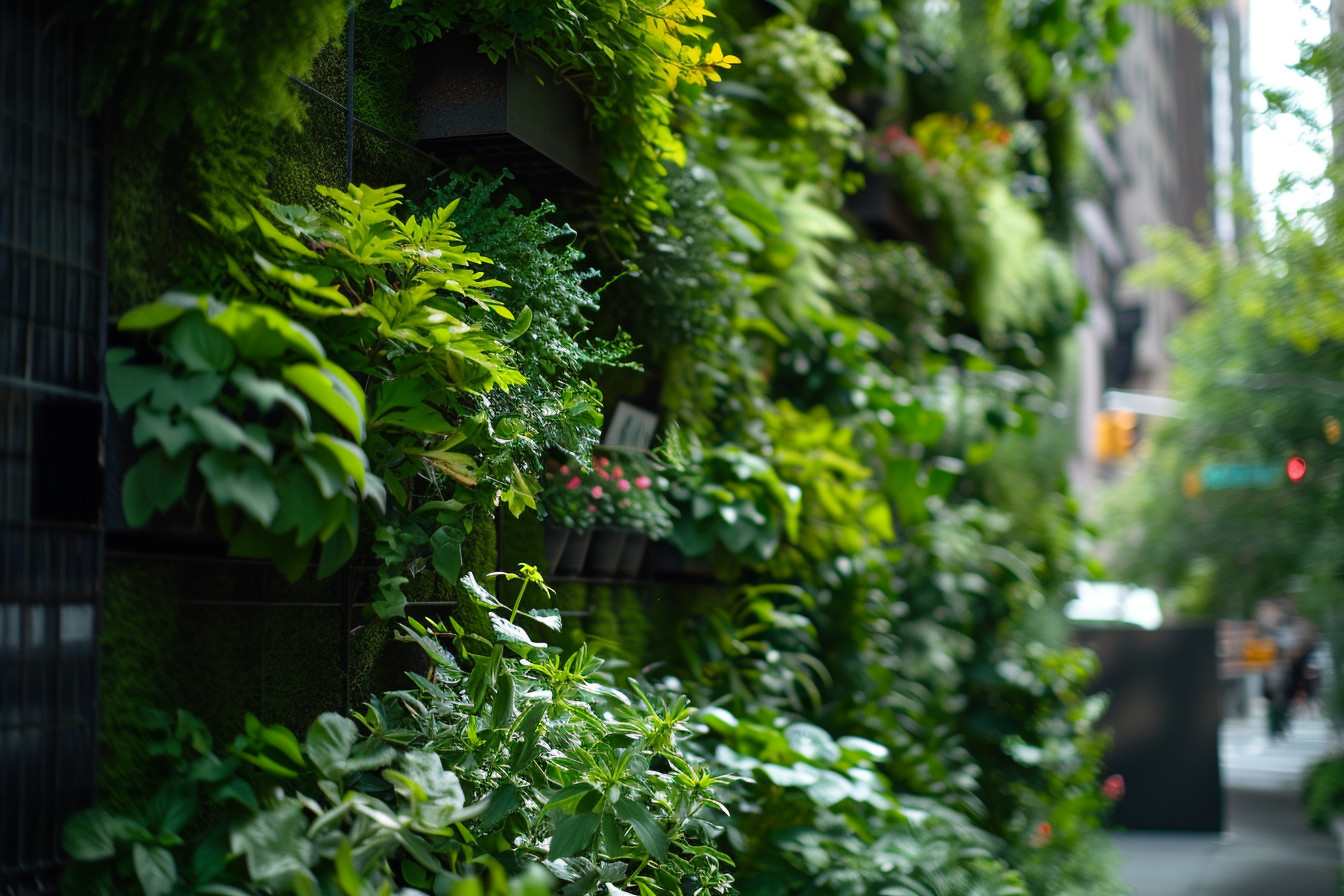As I stroll through the concrete jungle of my urban neighborhood, I can’t help but feel a sense of calm wash over me when I spot a vertical garden. It’s like a breath of fresh air amidst the hustle and bustle. Vertical gardens aren’t just eye candy; they’re a game-changer for city living.
I’ve seen firsthand how these lush green walls transform bland exteriors into vibrant living art. They’re not just beautifying the cityscape; they’re bringing a slice of the serene countryside to our doorstep. It’s amazing how a bit of greenery can boost our mood and connect us with nature, even in the heart of the city.
Let’s dive into the world of vertical gardening and explore how this innovative practice can revolutionize our urban spaces. Trust me, it’s not just about aesthetics; there’s a whole lot more to this green trend than meets the eye.
What is Vertical Gardening?
Think of vertical gardening as a green uprising – in the literal sense. It’s the art of growing plants upward using trellises, panels, or stacks, rather than sprawling them across the garden bed. This technique is a space-saver’s dream in the concrete jungle where horizontal real estate is as scarce as a quiet moment in Times Square.
As I walk through the city, I can’t help but see the potential for these verdant installations on every blank wall or bare balcony. They’re like living art pieces, constantly evolving with each new sprout and bloom. Vertical gardens turn mundane structures into something out of a nature lover’s fairytale.
Beyond the visual allure, vertical gardens also allow for some intriguing horticultural experimentation. I’ve seen folks grow anything from succulents to edible herbs and even small fruit-bearing plants, all reaching for the sky. It’s not just for beautification; there’s a practical element to vertical gardens that turns urban spaces into productive green hubs.
The Mechanics Behind Vertical Gardens
You don’t need a biology degree to get the hang of it. Here’s where the gears shift, and I break it down: Systems for vertical gardening can range from simple DIY setups with hanging pots to sophisticated modular living walls. Whether it’s using pockets made of felt, stackable planters, or repurposing old wooden pallets, the core principle remains the same – guide the growth upward.
When I started my first vertical garden, I learned quite a bit about the importance of choosing the right plants. Not every plant is going to thrive in such a setup. You’ve got to consider sunlight exposure, watering needs, and the overall weight of the plants. And when we talk about watering, let’s not forget about irrigation systems that prevent overwatering – a common rookie mistake.
If you’re a tech-savvy gardener, you might even dive into hydroponics or aeroponics. Imagine plants nourished by nutrient-rich mist or water systems, all without a speck of soil in sight. That’s space-age gardening right there.
Benefits of Vertical Gardening in Urban Areas
Let’s dive into the benefits of vertical gardening, especially in those crowded urban jungles where space is as rare as a quiet morning. There’s a certain peace you find when tending to a garden that reaches up towards the sky—it’s like stitching a green tapestry on the fabric of the city.
From my own experience, transforming a bland balcony into a thriving vertical garden felt like I was bringing a piece of the countryside right into my fifth-floor apartment. These green walls aren’t just about aesthetics; they’re a peaceful rebellion against concrete monotony, gifting not only charm but a serene spot to unwind after a day spent in the urban frenzy.
When it comes to the technical bits, it’s pretty simple stuff really, so everyone can get their hands dirty. Picture a trellis or a series of shelves where you can plant a variety of green buddies—herbs, vegetables, even some fruits. There’s a lot to learn about which plants play nicely together and how to tend to them, but there’s nothing like the satisfaction of watching seedlings you’ve planted reach up and flourish.
I’ve seen community gardens transform entire neighborhoods. They become open-air classrooms where kids and grown-ups alike learn about nature’s cycles firsthand. They’re a reminder that despite all our pavement and steel, nature’s still got a foothold in the city.
And talk about benefits for your health—the feeling of soil in your hands, coupled with the joy of harvesting something you’ve grown, can do wonders for stress levels. Studies have shown that gardening activities decrease cortisol, a hormone often associated with stress. The relaxing nature of this green thumb business is no joke; it’s backed by science.
Here’s a quick look at some vertical gardening perks:
- Enhanced air quality
- Increased biodiversity
- Thermal insulation for buildings
- Reduced noise pollution
- Local food production
Let me tell you a story about my friend Zoe. She started with nothing but a few hanging pots and an old shoe organizer. Before long, she had this lush curtain of ferns and edible greens that not only cheered up the alleyway view but also caught the attention of her neighbors. It sparked a green chain reaction, and now that dreary space is full of chattering folks and flourishing plant life.
Maximizing Limited Space
Ever walked through a city and stumbled upon a slice of green heaven tucked between concrete giants? That’s the magic I’m talking about when I discuss vertical gardening. Space is a premium in urban jungles, and horizontal patches of earth are often as scarce as a quiet moment in Times Square. But look up, and you’ll realize there’s a whole canvas waiting to be painted with the greens and florals of nature.
I’ve seen firsthand how a mundane balcony or a grim-looking wall can turn into an oasis with a bit of ingenuity and a love for gardening. It’s like finding extra closet space you never knew you had. My friend’s vertical garden, which sparked that green chain reaction in our neighborhood? It was an ingenious solution to space scarcity. She stacked planters one on top of the other and used hanging pots, turning a small area into a lush landscape.
Creating a vertical garden isn’t just stacking up a bunch of pots though. It takes a thoughtful approach, considering the weight of plants, the strength of structures, and the direction in which the sun kisses the leaves each morning. I like to think of it as piecing together a life-sized puzzle where each plant finds its place.
But what’s truly remarkable is how vertical gardens can flex to fit different environments. Take trellises, for example. They’re not just for English cottages and vineyards. I’ve seen urban homes with trellises that support everything from flowering vines to tomato plants, all the while taking up barely a foot of ground space. And let’s not forget about repurposed materials—old wooden pallets, metal grids, even shoe organizers have been turned into growing spaces. It’s gardening meets DIY, and the results can be stunning.
One tool I’ve found indispensable is the pocket planter. They’re pretty much hanging fabric or plastic organizers with slots for plants, and they’re perfect for herbs and small vegetables. Plus, when you water the top row, it trickles down—kind of like a built-in irrigation system.
Enhancing Aesthetics and Improving Air Quality
I’ve always believed that urban gardens are much more than a means to get fresh produce. They’re a way for city dwellers to reclaim space and bring a touch of serenity to the concrete jungle. Take vertical gardening, for instance. It’s not just about maximizing space; it’s about transforming our living environment. I remember the first time I saw a vertical garden in the city. It was a patchwork of vibrant greens and florals effortlessly cascading down a somber gray building. I was captivated by how it contrasted the stark urban landscape—it was like a living mural.
Of course, the beauty of these gardens isn’t merely skin-deep. Sure, aesthetic appeal is a major pull, but did you know they’re also mighty warriors in the fight against urban pollution? Here’s the scoop: plants in vertical gardens act like natural air filters. They absorb the not-so-great stuff, like carbon dioxide and particulates, and in exchange, they pump out fresh oxygen. Talk about a breath of fresh air—literally! When I learned about this, I started looking at the leafy facades and green walls differently; they’re not just pretty, they’re functional, breathing life back into our cities.
Educational tidbit for you—some plants are particularly good at this air-cleaning job. Spider plants, peace lilies, and Boston ferns are like the superheroes of the plant world. But it’s not only about choosing the right green guardians for our urban oases. We gotta think about their placement, maintenance, and the kind of pocket planters and growing media they’ll need to thrive.
Let’s get technical but keep it real simple. Ever heard of PM10s? They’re particulate matter 10 micrometers or smaller—these tiny particles are a big deal because they can mess with our lungs. Plants trap these particles on their leaves and then wash them away with the rain. Neat, right? It’s akin to having an army of tiny environmental janitors.
Growing Your Own Produce
I’ve got to share how vertical gardening has revolutionized the way I grow my own veggies and fruits. It’s like a little supermarket right in my backyard! Knocking on heaven’s door does wonders for the soul, and there’s something almost meditative about tending to your own crops. They say to stop and smell the roses but trust me, snipping fresh basil straight from your wall-mounted herb garden is a whole other level of Zen.
Let me give you the lowdown on how vertical gardening is perfect for producing your own fresh food. I learned heaps over the years, and the best way to master it is by doing. Starting with herbs and moving up to strawberries hanging from baskets, I’ve come to realize the potential of even the smallest spaces. Whether you’re working with a sunny balcony or a few feet by the kitchen window, there’s a vertical gardening solution for you.
Now we’re not just talking a couple of planters. Picture transforming a bland wall into a vibrant lattice of tomatoes and lettuce with cascading vines of peas and beans. And let’s not forget the technical stuff – it’s pretty straightforward. First things first, you need a reliable structure that can handle the weight of soil and water. I rigged up a system with shelves and some sturdy pots. I had to make sure the sunlight hit just right, which meant a bit of trial and error at first.
When it comes to choosing plants, it’s all about those light, nutrient, and space needs. I’ve found that veggies like spinach, cherry tomatoes, and herbs are less demanding and super grateful – give them a bit of love and they’ll flourish. And remember, proper irrigation is key. I set up a simple drip system that keeps my vertical veggies hydrated without me having to haul a watering can up a ladder every day.
But why go through all this trouble, you might wonder? Well, nothing beats biting into a crisp cucumber that I’ve just plucked from my own green assembly line. Plus, there’s this sense of ownership and satisfaction that comes from tending to your plants and watching them grow – it’s pretty indescribable.
And hey, if you’re into sustainable living, growing your own produce checks so many boxes. You’re slashing food miles, cutting down on plastic packaging, and ensuring you’ve got the freshest, pesticide-free produce at your fingertips.
Incorporating Vertical Gardens in Urban Infrastructure
I’ve always marveled at the tranquility that green spaces bring to the bustling life in the city. There’s something about the integration of nature into our daily commutes and concrete jungles that offers a soothing break from the norm. As we delve deeper into the future of city planning, I can’t help but advocate for the conscious inclusion of vertical gardens in urban infrastructure.
Imagine walking down the street, the air is cleaner and the atmosphere calmer, thanks to the lush layers of greenery climbing up the sides of buildings. It’s not just a dream. City planners and architects are increasingly recognizing the value of incorporating vertical gardens into their designs. These green additions offer a serene escape and a touch of nature amidst the urban sprawl. They’re not just for show; vertical gardens provide essential green space while maximizing the limited square footage available in urban settings.
Let’s talk about the educational side for a moment. The concept of vertical gardening isn’t new. It has roots in ancient civilizations, but it’s come a long way since hanging gardens and ivy-covered walls. Today, there are entire movements dedicated to the proliferation of green walls and edible towers, transforming dull infrastructures into vibrant ecosystems. This leap forward in urban design is a teaching moment for communities. It spawns discussions on sustainability, self-reliance, and the benefits of local food systems, all while improving mental and physical health for urbanites.
Technically speaking, setting up a vertical garden is simpler than it looks. You just need a supporting structure, the right mix of plants, and a basic irrigation system. The magic happens when you find the synergy between the necessary practicality and the potential aesthetics of the installation.
From my experiences, there’s no one-size-fits-all approach to integrating vertical gardens into urban infrastructures. Every space calls for a bit of ingenuity. Take pocket gardens, for example. By using pockets made from felt or other materials, buildings can have small, self-contained ecosystems on their walls. It’s a simple, accessible solution that can be tailored to fit any urban space.
Final Thought
So there you have it—vertical gardening isn’t just a trend; it’s a transformative approach to urban living. I’ve seen firsthand how a vertical oasis can not only beautify a space but also contribute to a healthier, more sustainable environment. Whether it’s the joy of biting into a cherry tomato straight off the vine on your balcony or the tranquility of ferns fluttering in the breeze outside your window, the rewards are tangible. And let’s not forget the ripple effect of inspiration it can cause in a community. So why not grab a planter, pick out some seeds, and start your own vertical garden journey? Trust me, your urban oasis awaits!









